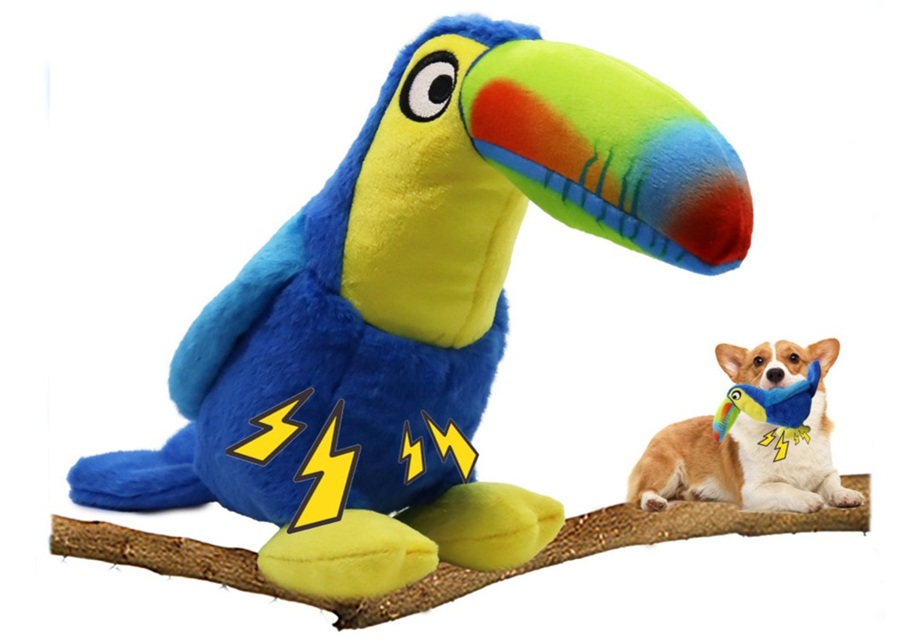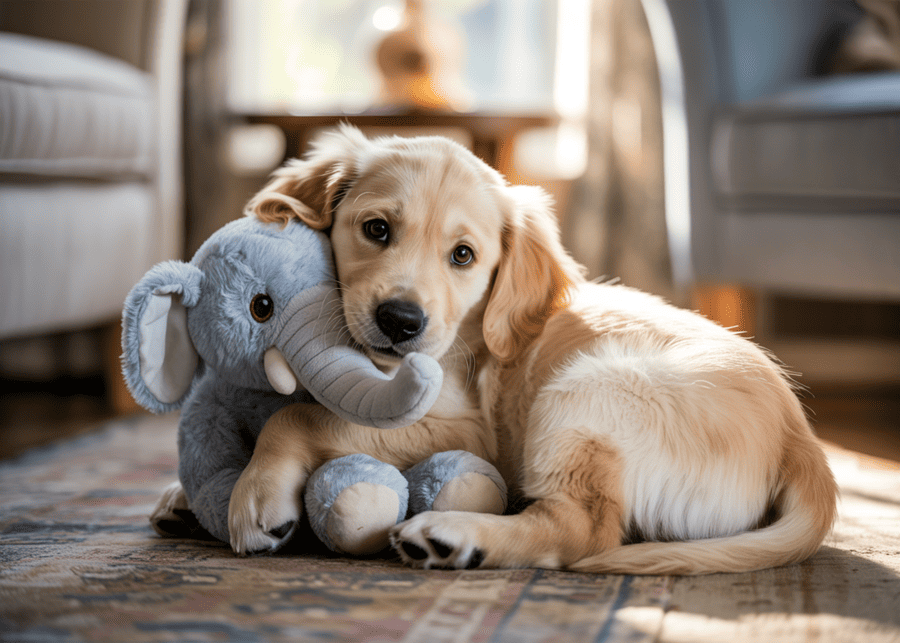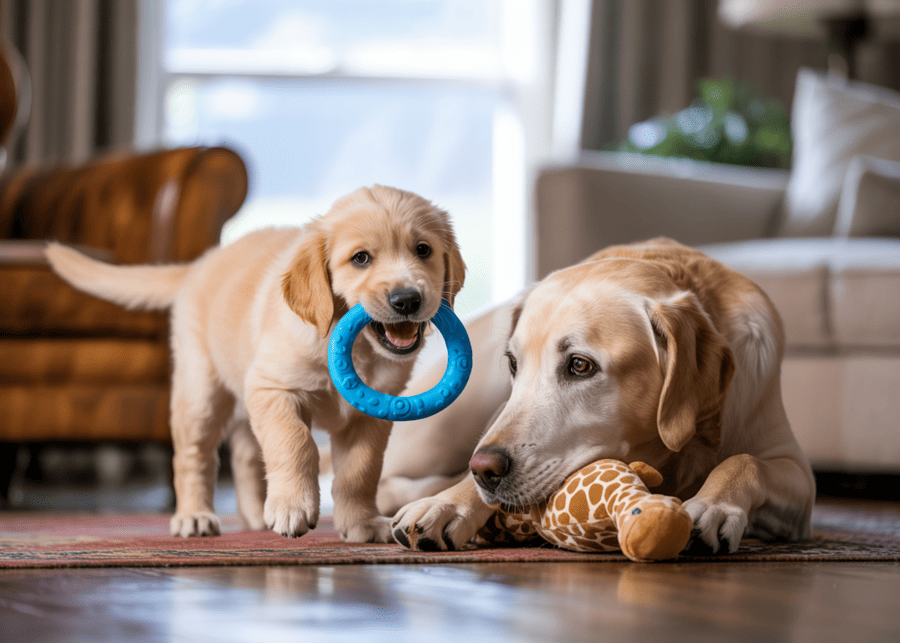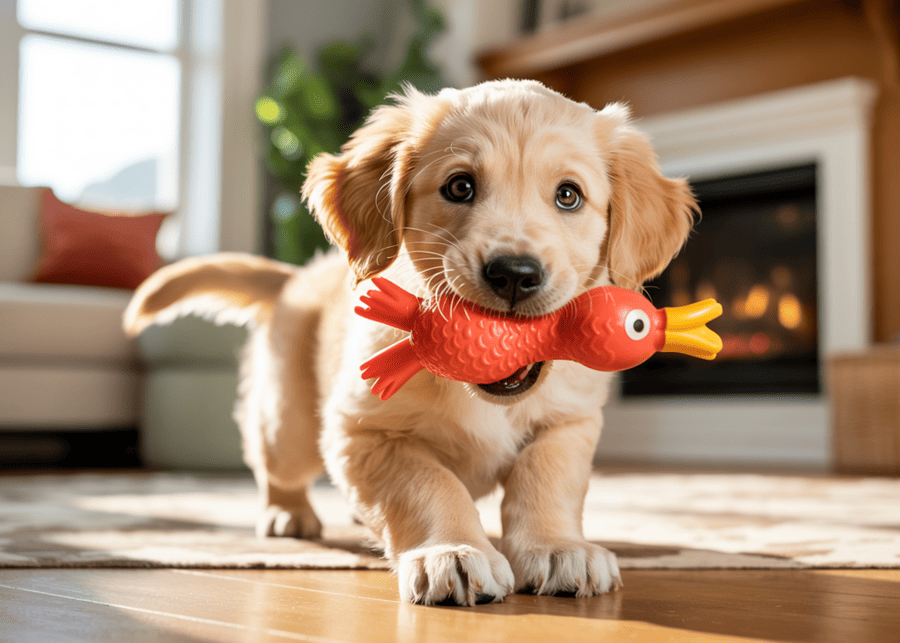Your dog seems bored, which can lead to destructive behavior. Giving them a toy is the simple answer, but understanding why they love them is the key to true enrichment.
The primary reasons dogs love toys are rooted in their natural instincts. Toys satisfy their innate prey drive, provide essential mental stimulation, prevent boredom, and offer a powerful way for them to bond with you through interactive play.

As someone who has spent over a decade manufacturing pet supplies for brands worldwide, I’ve seen firsthand how the right toy can transform a dog’s day. It’s not just about a simple object; it’s about tapping into what makes a dog a dog. From the thrill of the "hunt" with a squeaky toy to the mental workout of a puzzle feeder, toys serve a deep purpose. Understanding this purpose helps us, as owners and industry professionals, choose the best products to keep our furry friends happy and healthy. Let’s dive into the fascinating world of canine play and find out what really drives their love for toys.
What Science Says About Dogs and Toy Attachment?
Is your dog’s love for their favorite toy just a cute habit? It might be more, a deep-seated behavior that has a real scientific basis you can understand.
Science suggests dogs form attachments to toys due to a combination of instinct, brain chemistry, and social bonding. Play releases dopamine, making it feel good, while the toy itself can act as a substitute for prey, fulfilling a natural hunting drive.

When we look deeper, the connection is fascinating. It’s not just random fun; it’s a biological process. As a manufacturer, we consider these factors when designing toys because a successful product works with a dog’s nature, not against it.
The Brain on Play
When a dog engages with a toy, its brain chemistry1 changes. The act of chasing, chewing, and "capturing" a toy triggers the release of dopamine, a neurotransmitter associated with pleasure and reward. This creates a positive feedback loop: playing feels good, so the dog wants to play more. This is especially true for toys that provide immediate feedback, like a squeaker.
Instinct and Experience
A toy’s appeal is also rooted in a dog’s ancestry. Here’s a breakdown:
- Prey Drive: A plush toy that squeaks or crinkles mimics the sounds and feel of small prey. Shaking the toy taps into the instinct to "kill" the catch. This isn’t aggression; it’s a healthy outlet for a hardwired behavior.
- Comfort and Security: Some dogs, much like human children with security blankets, use a favorite soft toy for comfort. It can smell like them or their home, providing a sense of security when they are alone or anxious. This is why we often see dogs cuddling with a specific plush toy.
What Makes Dogs Obsessed with Certain Toys?
Ever wonder why your dog ignores a brand-new toy for their old, raggedy one? It’s not random; specific features make some toys completely irresistible to our canine companions.
Dogs become obsessed with certain toys because they engage multiple senses and instincts. Toys with unique sounds, textures, or challenges—like squeaky, puzzle, or interactive toys—tap directly into a dog’s natural behaviors, making them highly rewarding and engaging.
In producing toys for global brands, we’ve learned that the secret to a "favorite" toy lies in its ability to satisfy a dog’s core needs. This obsession is actually a sign of a well-designed product that provides excellent enrichment.
The Sensory Appeal
A dog experiences the world through its nose, mouth, and ears far more than we do. A toy’s success often depends on how well it stimulates these senses.
- Sound: Squeakers and crinkle paper are huge hits because they mimic the sounds of prey. The high-pitched squeak can sound like a small, frightened animal, which triggers a dog’s hunting instinct. The immediate auditory feedback—"I bite it, it makes a noise"—is incredibly satisfying.
- Texture: The feeling of a toy in a dog’s mouth is critical. Some dogs love the soft, tearable feel of a plush toy, while others prefer the firm resistance of a rubber chew toy. This preference is often linked to their individual chew style and breed.
- Challenge: Puzzle toys and treat-dispensing toys are captivating because they present a problem to solve. They engage a dog’s brain, forcing them to think, paw, and nudge to get their reward. This mental work is just as important as physical exercise.
How Do Different Dog Breeds Prefer Different Toys?
Have you noticed your Golden Retriever loves plushies while your friend’s Border Collie only wants a frisbee? Breed plays a huge role in what toys a dog will enjoy most.
Different dog breeds prefer different toys because they were originally bred for specific jobs. Herding dogs often love fetch toys, retrievers enjoy carrying soft items, and terriers may prefer toys they can "kill," like squeaky plushies.
Understanding these breed-specific tendencies2 is something we focus on when developing product lines for our clients. A one-size-fits-all approach doesn’t work. To help you choose the best toy, let’s look at what different breed groups are naturally drawn to.
Matching Toys to Breed Instincts
A dog’s historical purpose is the biggest clue to its modern-day play preferences. Here’s a simple guide to help match a toy to a breed’s instincts.
| Breed Group | Common Breeds | Instinctive Behavior | Recommended Toy Types |
|---|---|---|---|
| Herding | Border Collie, Australian Shepherd | Chasing, controlling movement | Frisbees, balls, durable fetch toys |
| Retrievers | Labrador, Golden Retriever | Carrying things in their mouth | Soft plush toys, rubber balls, dock diving toys |
| Terriers | Jack Russell, Westie | Shaking, "killing" prey | Squeaky toys, durable plush toys, tug ropes |
| Hounds | Beagle, Basset Hound | Following scents, problem-solving | Scent-work toys, puzzle feeders, treat-dispensing toys |
| Working | Rottweiler, Siberian Husky | Pulling, powerful chewing | Heavy-duty chew toys, tug-of-war ropes, weighted toys |
Of course, every dog is an individual. My own experience shows that even within a breed, there are personal preferences. However, starting with their natural instincts is the best way to find a toy they will truly love and engage with.
How Do Toy Preferences Change as Dogs Age?
Did your puppy’s favorite chew toy get ignored once they grew up? A dog’s toy needs are not static; they change dramatically from their puppy days to their senior years.
Puppies need toys for teething and learning, so they prefer durable chew toys and interactive puzzles. Adult dogs enjoy a variety based on their breed, while senior dogs often seek soft, comforting plush toys that are gentle on their mouths.

Recognizing these life-stage needs is crucial for a dog’s well-being. As a manufacturer, we design different products specifically for these age groups, ensuring safety and appropriate stimulation. Let’s break down the toy box for each stage of a dog’s life.
From Teething Pains to Golden Years
A dog’s physical abilities, energy levels, and even dental health change over time, and their toys should reflect that.
- Puppies (0-1 Year): This is the age of exploration and, most importantly, teething. Puppies need durable rubber toys that can soothe their sore gums. It’s also a critical time for learning, so interactive puzzle toys are perfect for early cognitive development. Avoid toys that are too hard or can be easily shredded and ingested.
- Adults (1-7 Years): This is a dog’s prime. Their toy preferences are fully formed and often tied to their breed and personality. This is the time for variety: durable chew toys for dental health, fetch toys for exercise, and puzzle toys for mental stimulation.
- Seniors (7+ Years): As dogs age, their energy decreases and their teeth can become more sensitive. They may lose interest in intense chewing or vigorous games of fetch. This is when softer, lighter toys become ideal. Many senior dogs find great comfort in a soft plush toy they can gently carry or cuddle with. Low-impact puzzle toys can also help keep their minds sharp without being physically demanding.
Why Do Dogs Like Squeaky Toys So Much?
Is there any sound more capable of getting your dog’s instant attention than a squeak? The intense, immediate reaction dogs have to squeaky toys isn’t just a quirk; it’s a deep-seated instinct.
Dogs love squeaky toys because the high-pitched sound mimics the noise of injured or frightened prey. This triggers their innate prey drive, making the act of biting and shaking the toy an incredibly satisfying and rewarding experience.

In my experience manufacturing plush toys, the squeaker is often the most important component. We’ve seen how adding one can turn an ignored toy into a favorite. This isn’t just about making noise; it’s about providing instant gratification that speaks directly to a dog’s brain.
The Thrill of the "Hunt"
The obsession with squeaky toys is a direct link to a dog’s wild ancestors, who needed to hunt to survive.
- Instant Feedback: When a dog bites down and the toy squeaks, they get immediate confirmation that they have "captured" their prey. This sound tells their brain, "You did it!" This creates a powerful and addictive feedback loop that keeps them coming back for more.
- Satisfying an Instinct: For most domestic dogs, there’s no outlet for their natural hunting drive. Squeaky toys provide a safe and fun way to engage in this behavior. The act of finding the squeaker, biting it, and "killing" the toy by shaking it is a deeply fulfilling activity.
- Encouraging Play: The exciting sound of a squeaker can entice even reluctant dogs to play. It grabs their attention and encourages them to interact, making it a great tool for initiating playtime and bonding with your pet. This is why we often recommend squeaky toys to our clients, like Garrett, who wanted to create a fun, engaging plush toy for his pickleball brand.
How Do Interactive Toys Improve Dog Mental Health?
Is your dog showing signs of boredom, like chewing furniture or excessive barking? Physical exercise isn’t always enough; dogs need mental workouts too, and that’s where interactive toys shine.
Interactive toys improve a dog’s mental health by providing crucial cognitive stimulation. They challenge a dog’s problem-solving skills, prevent boredom-related anxiety and destructive behaviors, and build confidence as the dog learns to solve the puzzle for a reward.
From our perspective as a one-stop sourcing partner for retailers like Judy in Germany, we’ve seen a huge increase in demand for puzzle and interactive toys. Pet owners are realizing that a tired dog is good, but a mentally fulfilled dog is even better.
More Than Just a Game
Interactive toys are essential tools for canine enrichment that offer benefits far beyond simple play. They work by making a dog think strategically to achieve a goal, which is usually to get a treat.
- Boredom Busting: Many behavioral problems stem from a lack of mental engagement. A dog left alone with nothing to do will find its own (often destructive) entertainment. A puzzle toy can keep a dog occupied for a significant amount of time, channeling their energy into a positive activity.
- Building Confidence: When a dog successfully solves a puzzle, it’s a victory. This process of trial, error, and eventual success builds their confidence. It’s especially beneficial for timid or anxious dogs, as it teaches them they can overcome challenges on their own.
- Slowing Down Fast Eaters: For dogs that gobble their food in seconds, treat-dispensing toys are a fantastic solution. They turn mealtime into a game, forcing the dog to eat more slowly, which is better for their digestion and helps prevent bloating.
What Role Do Toys Play in Dog Training Success?
Are you struggling to keep your dog focused during training sessions? Sometimes, the best motivator isn’t a treat; it’s their favorite toy, which can be a powerful tool for success.
Toys play a crucial role in dog training by acting as high-value rewards for good behavior. They are also essential for teaching commands like "fetch" and "drop it," and for making training sessions fun, which strengthens the bond between you and your dog.

As a partner to many pet brands, we emphasize that toys are not just for play; they are functional equipment. Using them correctly can make training more effective and enjoyable for everyone involved.
Toys as a Training Tool
Integrating toys into your training routine can unlock new levels of engagement, especially for dogs who aren’t highly motivated by food.
- High-Value Rewards: For many dogs, a few seconds of tug-of-war is more rewarding than a biscuit. Use a favorite toy as a prize for successfully executing a command like "sit" or "stay." This is especially effective for high-energy breeds.
- Teaching Essential Commands: Toys are fundamental for certain skills.
- "Fetch": This classic game teaches a dog to retrieve and return an object.
- "Drop It": This vital command teaches a dog to release whatever is in their mouth. Practicing with a toy is a safe and controlled way to master this skill.
- "Go to Your Place": You can teach a dog to go to their bed or mat by tossing a toy there.
- Building Positive Associations: If a dog sees training as a fun game that involves their favorite toys, they will be much more eager to participate. It transforms training from a chore into a highlight of their day, strengthening your relationship and making them a more willing student.
Conclusion
Toys are essential for a dog’s happiness, tapping into their core instincts. Preeminent helps you design and manufacture custom toys that dogs will love and customers will buy for your brand.


